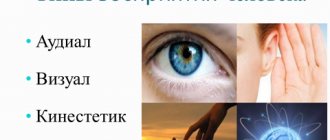A person perceives information through the main five channels: visual, auditory, tactile, gustatory, olfactory. And after perception, the information is processed in our head, and the interesting thing is that it is processed on the basis of one prevailing system .
There are four main types of sensory systems:
- Visual. When the visual information processing system is dominant: shape, location, color.
- Auditory. The auditory information processing system is dominant: sounds, melodies, their tone, volume, timbre, purity
- Kinesthetic. Sensory information is dominant: touch, taste, smell, sensation of textures, temperature
- Digital. Associated with the logical construction of internal dialogue.
One should not think that the dominance of one means the weakness of the other. It’s just that one of the systems is most often the starting, leading one. It is the leading system that launches the thinking process and becomes the impetus for other mental processes: memory, representation, imagination.
How can you determine who you are: visual, auditory, kinaesthetic or digital by speech?
Carefully monitor your speech and write down exactly the phrases that you use to indicate your opinion and your actions. Most often, a person of a particular type of perception uses phrases characteristic of this modality.
Visual
Uses words and phrases related to visual actions : I didn't see, I saw, I noticed, I think it was colorful and great, it looks, focus is concentrated, contrast, perspective, you see.
Audial
They often use phrases with auditory phrases : I can’t understand what you’re saying; didn't hear; I heard it; I recently heard; glad to hear from you; I heard it; the idea sounds tempting.
Kinesthetic
This type of perception is characterized by phrases that show their emotional and bodily responses: I can’t stand it; it's disgusting; it is so sweet; goosebumps; so pleasantly warm; it was a powerful experience. Often their nonverbal signs are very indicative; facial expressions and gestures are telling and reflect the state and emotions of a person, even if there are not many nonverbal signs themselves.
Digital
Digitals pay attention to logic and connections. A specific set of words is not typical for them: phrases of auditory and kinesthetic types may appear. Digital people often ask: what is the point of this; I don’t understand how this is connected; I would like to bring everything into a system; we need to streamline this somehow. However, such expressions are typical of most types with a good sense of organization. Therefore, identifying digital from speech must be done with great care.
Each type has its own characteristics that affect its perception of surrounding information, any educational processes, and interaction with other people. Let us analyze the characteristics of people of different types of perception.
Visual, auditory, kinesthetic, digital in the learning process
If you study a lot, go to courses, trainings, read, then understanding your own type of perception will help you organize your own learning process with maximum benefit.
Visuals
The basis of their learning is visual information. For visual people, hearing and vision form a single whole, therefore, if such a person only heard the material (but did not see), then with a high degree of probability the information will be quickly forgotten. Visual learners instantly absorb all visual information, so it is most beneficial to use all methods and techniques for visually presenting the material:
- mind maps
- scheme
- graphs
- illustrations
- photos
- demonstration models
- experiments, experiments
Visual learners learn best through visual examples, where they see the material they are learning in real time. Primary memory is visual. They remember well the location of objects, paths, roads, and are well oriented in space. Some noise is not critical for a visual learner; he can concentrate in an environment of some noise and successfully study the material.
Visual learners perceive text information well and are able to quickly learn speed reading.
Audial
Uses the auditory perception channel as a trigger. Inner speech is moderately developed. They perceive lectures, music, conversations, and dialogues well. They clearly and effectively maintain the line of conversation and conversation; often it is during the conversation that they grasp the meaning of the material being studied. Silence is necessary when concentrating. If you are an auditory learner, then be sure to listen to lecture material and audio courses. Learn together with others, discussing the topic being studied, thinking out loud about the problem.
Kinesthetic
Receives information through actions and movements. He remembers any actions and practical exercises well. He perceives all information best through practical exercises and experiments, where he tests the information received with his own hands in practice. Information of a practical nature is especially well perceived: what moves and how, where to click.
It is important for kinaesthetic learners to feel, touch, smell, taste and fully experience the subject being studied. People of this type are very active, love and enjoy working. And they don’t like inaction. It is for kinesthetic learners that the saying “Movement is life” has a special meaning. It is very difficult for kinaesthetic people to maintain focus, they are easily distracted, it is difficult for them to sit still for a long time, or to do routine work.
Digital
They are well trained in all sciences that have strict logic and consistency: mathematics, physics, mechanics, technology. Such people often work in areas where there is a lot of research, mathematical and static processing, and programming. The main thing for digital is to understand the logic and connections in the material, to organize what is being studied into a system with clear cause-and-effect relationships. Therefore, during your studies, try to build the logic of the entire topic being studied. For this you can use:
- scheme
- mind maps
- compressed plans
- Personally compiled thesauri
The concept of “REPRESENTATIVE SYSTEM”
When interacting with the world around us, we receive information about it through sensory channels (representational systems) - visual, auditory, kinesthetic and discrete (logical).
A science such as NLP (neurolinguistic programming), by studying oculomotor reactions (trajectory of movement of a person’s eyeballs), analyzing speech predicates, coupled with the study of his postures and gestures, very effectively determines the leading representative system of a person.
Recommended on the topic: You don’t owe anyone anything. Except for yourself... Is this so? Components of the Self
This is the dominant sensory channel through which information about the environment enters the human brain.
Visual, auditory, kinaesthetic, digital in communication
Visuals
“You meet people by their clothes...” the beginning of this famous proverb applies entirely to visual people. They attach significant importance to a person’s appearance and always pay attention to how a person looks, what clothes he is wearing, what facial features he has, how he moves.
When communicating, they can look into the eyes calmly and for a long time. Visual contact, inverted posture in communication, open postures are extremely important for the visual person. At the same time, they do not like to be close to their interlocutor and keep their distance. The main thing is to see well. Representatives of this type of perception quickly intuitively read the signals of body language and facial expressions, often without noticing it. Sometimes it seems to them that just by looking at them they know the thoughts of another person.
If you need to impress a visual person, try to pay the most attention to external beauty. The environment, your clothes, gait, facial expressions, and gestures should be as inviting as possible. To prove your words, provide clear examples, graphs, drawings, and be sure to demonstrate your arguments using samples and experiments. Show a picture instead of numbers: visual learners will have difficulty understanding the difference between 1000 and 10,000, but a visual example of the difference will convince them in most cases.
Visual artists themselves are good storytellers. They can imagine amazingly vivid and detailed pictures and talk about them for hours.
Audial
A conversation with an auditory student is often very pleasant. Auditory learners themselves are demanding of their speech; they speak measuredly, with competent changes in intonation. It’s nice to listen to them, it’s nice to talk to the auditory. But auditory learners themselves are very demanding of the speech of their interlocutors; they cannot tolerate errors in speech, incomprehensible and distorted speech. It is absolutely forbidden to shout or raise your voice at auditory learners; this will lead to alienation of the person. Audials are always a pleasure to listen to; they are wonderful storytellers and no less wonderful interlocutors, who can understand at a glance by their intonation and manner of speech.
Kinesthetic
Kinesthetic learners are especially sensitive to spatial surroundings and distances between interlocutors. Close people are allowed into the personal zone, but people they don’t know well are kept at a distance. For kinesthetes, an invasion of their personal zone is offensive, and they begin to experience strong negative emotions. It is best to gain the attention and trust of the kinaesthetic through actions, joint affairs, and common activities.
If you have to remember something, it is better to write it or draw it yourself. Conversations and verbal evidence will make the least impression on a person of this type of perception. And the kinaesthetic always strives to touch and stroke close people. Physical contact is important to him.
Digital
They are insensitive in communication and rarely show emotions in public. Particular attention is paid to the semantic, substantive part of the conversation. Beautiful but empty speech is unpleasant to them. With digital, it is best to get to the point in a conversation, proving the logic and correctness of your words with numbers and facts.
How to develop your sensitivity
Using the questionnaire, clarify your affiliation according to Efremtsev’s classification. Think about how often you notice yourself exhibiting a leading type of perception. The main way to develop it is to become aware of your characteristics and practice trusting your feelings. If you feel the need to touch an item, do so. If you feel more comfortable moving your lips while reading, don’t stop yourself. If you need to switch to pictures with beautiful landscapes while working, allow yourself this. And if it’s hard for you to keep all your plans and tasks in your head, draw up a detailed diary and cross off things as you complete them. Be yourself and use your unique capabilities.
Features of each type of perception
Visuals
The peculiarity of this type of people is that they are receptive to what is visible. They appreciate beauty in the surrounding space and do not tolerate disorder or dirt well. In the life of a visual person there are many ideas, dreams, dreams. They are often generators of ideas, since they can create completely unusual associations and connections in their imagination.
Audial
They perceive the world around them, paying especially close attention to sounds. They love music, melodies, and can often hum to themselves and hum songs. Sensitive and receptive to conversations, auditory people have acute hearing and good memory, especially auditory memory. They often choose as their occupation everything related to music, melodies, and oratory.
Kinesthetic
Kinesthetics are very sensitive to everything that happens around them. Their bodily and emotional sensations are closely intertwined. They love bodily comfort, the convenience of the surrounding space. Uncomfortable clothing or a thread tickling their neck can irritate a kinaesthete student. They love deep personal discussions, communication with emotional exchange, discussion of how others feel. For the kinesthete, touch has the deepest meaning and great value.
Digital
People of this type of perception are rarer. They tend to perceive the world around them through inner speech, through dialogue with themselves. Such people are primarily focused on the perception of meaning, logic, and consistency. Digital people always strive to understand and comprehend the essence of what is happening. They may be sensitive and vulnerable, but the world is interesting to them from the point of view of understanding meaning and logic, patterns. In a stressful situation, it is digitals that best maintain composure and calm, and can maintain clarity of thought and perception of the surrounding space.
Strictly speaking, the distribution of people into visual, auditory, kinaesthetic, and digital types is very simplified. In fact, each of these types can be mixed, or maybe with a different leading hemispheric system, which increases the number of options. But we'll talk about this later.
Of course, in each of us there is no pure one type of perception, sometimes they are mixed, sometimes the type of perception is different in a calm and emergency environment, in different situations. But understanding your leading system will allow you to better assimilate any information, understand your interlocutor and better convey your thoughts to him. Understanding your type of perception (visual, auditory, kinesthetic, digital) will allow you to understand how to study specifically for you, taking into account your individual characteristics.
Kinesthetics
Around the world, approximately 20% of people are kinesthetic learners. This is a person of feelings and sensations, his perception of the world is by touch, that is, with the help of movements and through smell and touch. Kinesthetics are characterized by the fact that they breathe deeply through the stomach, rather than through the chest.
They have a low, deep, hoarse or muffled voice, and their speech is slow, separated by expressive pauses. Kinesthetic people tend to slouch and sit slightly leaning forward. Their gaze is almost always downward. In clothing, they value, above all, comfort, relegating its appearance to the background. By nature, kinesthetic people are very gentle and good-natured people , always cheerful and with a good sense of humor. Their image is complemented by plump lips and pink skin; they tend to be overweight.
A kinesthetic person is, first of all, a person of action. To learn something, they need to put it into practice to better understand the information. If a kinesthetic learner needs to study the instructions for using something, then he will rush to try it out in practice one day, rather than re-read its contents many times. But this does not mean at all that representatives of this type are too mobile; it is easier for them to understand the world around them.
Kinesthetic learners have very well developed muscle memory, so they quickly memorize various motor actions ; sports such as swimming and cycling are easy for them.
For a person who is kinesthetic, the following expressions are typical:
- "make contact";
- "I feel";
- "change for the better";
- "to catch something";
- "hand in hand";
- "solid foundation";
- “manage oneself”;
- "keep calm";
- “We are very close to solving the problem.”
Kinesthetic learners, unlike visual learners, simply love touching and hugging, even with strangers. Their personal space does not have clear boundaries, so kinesthetics will not take closed poses and reject the desire of another person to approach them. After all, they are sure that they can get to know a person better and make friends with him mainly through touch. However, kinesthetics are not ready to let everyone into their inner world, but only the “chosen ones.” It is not surprising that kinesthetics have a unique ability to experience strong and deep feelings , and their attachments are strong and durable.









